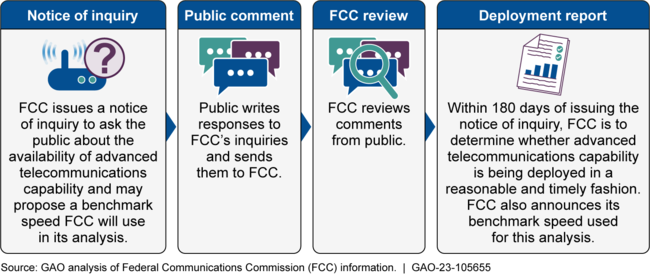Broadband Speed: FCC Should Improve Its Communication of Advanced Telecommunications Capability Assessments
Fast Facts
The Federal Communications Commission ensures access to broadband—high-speed internet—is deployed across the U.S. It uses a speed benchmark to assess whether broadband speeds are adequate and may take action to improve availability in areas where they aren't.
FCC annually assesses and reports on whether the benchmark should be updated to meet public needs. But FCC's reporting has been inconsistent over the years. For example, the agency looked at whether the benchmark speed was adequate for video conferencing in just 1 of 6 annual reports. Without consistent reporting, FCC's findings seem arbitrary.
We recommended that FCC address this issue.

Highlights
What GAO Found
The Federal Communications Commission (FCC) is required by statute to assess the deployment of broadband across the U.S. Although not explicitly required to do so, FCC uses its discretion to set a minimum fixed broadband speed that it uses as a benchmark. Since 2015, FCC has set this benchmark at 25/3 megabits per second (Mbps)—that is, 25 Mbps when downloading, which refers to the bits per second that travel to a user's device, and 3 Mbps when uploading, which refers to the bits per second that travel from a user's device. As part of its annual assessment of broadband deployment, FCC determines whether to change its broadband speed benchmark by soliciting public comment and analyzing information. See figure below for an overview of FCC's current process for reporting on broadband deployment.
Overview of FCC's Current Process for Reporting on Broadband Deployment

In examining FCC's six reports issued between 2015 and 2021, GAO found inconsistencies in the reported scope of FCC's analysis of benchmark speed and its reported rationale for updating or not updating the benchmark. For example:
- In five of the six reports, FCC reported on whether the current benchmark was sufficient for purposes such as video conferencing, but did not report on this in 2019.
- In the 2015 report, FCC considered future speed needs in its analysis; however, the other five reports did not discuss future speed needs, although FCC had received public comments on this topic.
- In the 2015 report, when FCC most recently changed the benchmark, it explained its rationale for making this change more thoroughly by citing research and its own data analysis. In contrast, in others years, FCC offered shorter, less thorough explanations.
Without consistently communicating the scope of its analysis and its rationale for setting the benchmark, FCC's reporting lacks transparency. Reporting on these issues in a more consistent manner year to year would provide stakeholders' better assurance that FCC's conclusions are not arbitrary.
Why GAO Did This Study
Access to broadband is critical for daily life. The Telecommunications Act of 1996 requires FCC to: (1) assess annually whether advanced telecommunications capability—which includes high-speed broadband—is being deployed in the U.S. in a reasonable and timely fashion, and (2) take action to accelerate deployment if FCC finds deployment is lacking. FCC sets a broadband upload and download speed benchmark as a metric for making this determination.
The Infrastructure Investment and Jobs Act includes a provision for GAO to review FCC's establishing, reviewing, and updating of the broadband speed benchmark. Among other things, this report examines the extent to which FCC has communicated how it reviews, and determines whether to update, the benchmark.
GAO reviewed relevant laws, regulations, and agency documents, and compared FCC's efforts to assess broadband deployment to FCC's strategic plan and relevant internal controls. GAO also interviewed FCC, selected federal and state officials; industry associations; broadband providers; and research organizations, to obtain their views on FCC's process.
Recommendations
GAO is recommending that the FCC's Chair provide consistent communication in its reporting on how FCC determines whether advanced telecommunications capability is being deployed and when updating the related metrics that FCC uses to assess broadband speeds and deployment. FCC agreed with this recommendation.
Recommendations for Executive Action
| Agency Affected | Recommendation | Status |
|---|---|---|
| Federal Communications Commission | FCC's chair should provide consistent communication in its reporting of how it determines whether advanced telecommunications capability is being deployed and when updating the related metrics it uses to assess broadband speeds and deployment. For example, FCC could report to the public the scope and steps of its research and analysis, the data and analysis used to support its assertions, and the rationale for why it agrees or disagrees with stakeholder comments it receives. (Recommendation 1) |
In a November 2023 letter, the FCC Chairwoman noted that transparency and consistency are important principles to FCC as it determines whether advanced telecommunications capability is being deployed in a reasonable and timely fashion. She further noted that, in October 2023, FCC issued its Notice of Inquiry for its latest assessment of broadband deployment. In that notice, FCC sought comments on ways it can provide consistent and transparent communications to the public about how it reviews, and determines whether to update, the advanced telecommunications capability evaluation metrics. When FCC issues its report on this proceeding, we will review FCC's analysis of these comments and what conclusions and decisions the agency reaches regarding changes to its reporting in accordance with our recommendation.
|
